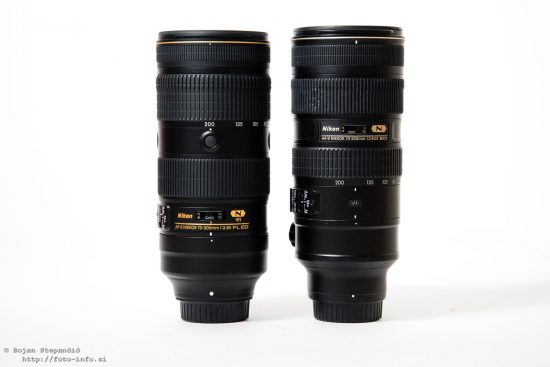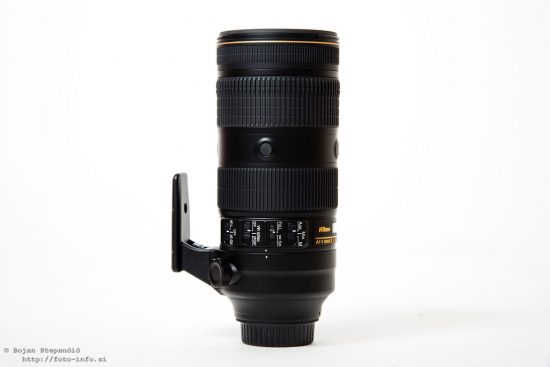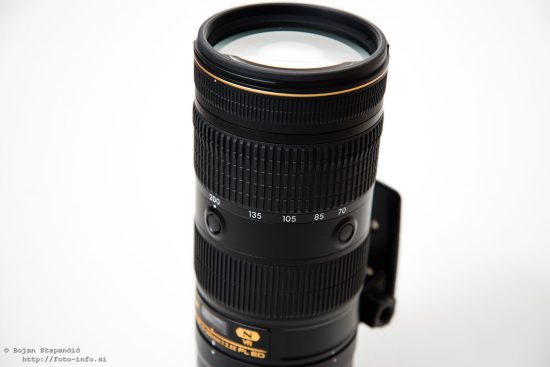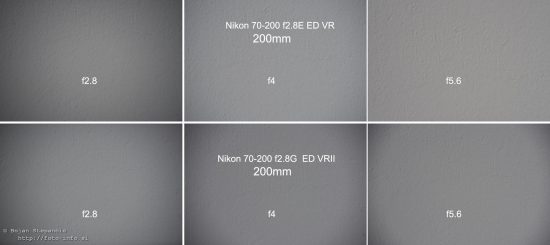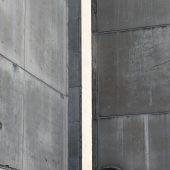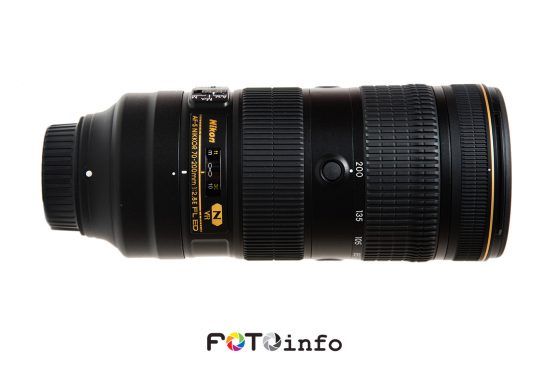
This review of the new Nikon AF-S Nikkor 70-200mm f/2.8E FL ED VR lens ($2,796.95) is by Bojan Stepančič (website: foto-info.si):
Nikon AF-S 70-200mm f2.8E FL ED VR is the newest tele-zoom lens by Nikon. After seven years, Nikon concluded that it is time to renovate the very popular lens, Nikon AF-S 70-200mm f2.8G ED VRII. The resolution of sensors that are built into DSLR cameras increased significantly and with it came the need for newer, sharper lenses. The new Nikon AF-S 70-200mm f2.8E FL ED VR lens has been thoroughly renewed, which was visible in positive results on this test. I made most of the test photos with both lenses, Nikon AF-S 70-200mm f2.8E FL ED VR and Nikon AF-S 70-200mm f2.8G ED VRII and compared the results.
Quality of manufacture and handling
On the first impression, the lens seems somewhat smaller, however this is due to a thicker lower part of the lens. The weight of the lens is, compared to the earlier version, 110g lighter, which is felt while handling. The biggest change is the relocation of thefocus ring and the zoom ring. The zoom ring has been moved to the front side of the lens, and the focus ring is now found at the backside of the lens. Special functional buttons have been added as well, that can be found between both rings and with which we can control the focus action.
Autofocus – AF
Nikon AF-S 70-200mm f2.8G ED VRII was already considered as an exceptionally fast and reliable lens regarding autofocus. Nikon AF-S 70-200mm f2.8E FL ED VR went in this sense even a step higher. During photography, I could quickly notice that the new lens is faster, so I decided to measure the time that each lens needs to focus from infinity to the closest position and back. Nikon AF-S 70-200mm f2.8E FL ED VR took between 0.40 and 0.45 seconds, while Nikon AF-S 70-200mm f2.8G ED VRII took between 0.60 and 0.65 seconds. The difference is thus quite considerable. The lens is very reliable and precise in focusing.
Vibration stabilization – VR
Both lenses produced sharp photos with up to 3 – 4 steps longer times, so there is not much difference here. However, there is a difference in response and speed of the vibration stabilization system, which is considerably improved in the new lens. The lens stabilizes the photo faster and photography is more intuitive with the vibration stabilization turned on. It is therefore not necessary to think much about the lens stabilizing the photo before we take a photo.
Ghosting and flare
While photographing into backlight there are, just like in the older model, problems with light reflection inside the lens itself, which is a consequence of a large number of optical elements and the fast aperture of the lens. However, Nikon AF-S 70-200mm f2.8E FL ED VR does come out a bit better than the older model. (click on photo for full-size image)
Cromatic aberation – CA
Also in this point, Nikon AF-S 70-200mm f2.8E FL ED VR is a bit better than the older lens. On test photos, you can notice CA only in very extreme situations. (click on photo for full-size image)
Focal length 200 mm and close-up photography
The problem that was brought to attention the most in the older lens Nikon AF-S 70-200mm f2.8G ED VRII, is the angle of the photo that the lens covers in close-up photography. With a focal length of 200mm in close-up photos with the old lens, it was noticeable that the focal length 200 mm was really more one of 135 mm. This has been considerably improved in the new Nikon AF-S 70-200mm f2.8E FL ED VR lens. The differences between both lenses in close-up photography are visible in the comparison below. (click on photo for full-size image)
Vignetting
I have to admit that the degree of vignetting with Nikon AF-S 70-200mm f2.8E FL ED VR, which appears at a focal length of 200 mm and an aperture of f2.8, somewhat surprised me. From the test photos it is visible that at 200 mm and f2.8 the vignetting is somewhat stronger than in the older lens Nikon AF-S 70-200mm f2.8G ED VRII. What surprised me the most is that the vignette at this setting reaches deeper towards the middle of the shot than in the older model. But the vignette in an aperture of f4 almost miraculously disappears. From the aperture of f4 on, the new Nikon AF-S 70-200mm f2.8E FL ED VR is considerably improved regarding vignetting. (click on photo for full-size image)
200mm f2.8 strong vignetting on Nikon 70-200mm f2.8E FL ED VR
Sharpness and contrasts
This is the point I was interested in the most. A completely new construction of the lens and the use of fluorite optical elements brought advantage compared to the older lens, at least on paper. You can see in the test photos below how the new Nikon AF-S 70-200mm f2.8E FL ED VR lens turned out in practice.
For the test I used Nikon D810, I photographed with the use of a tripod and self-timer, while checking the focus I used live view and zoomed into the center of the photo for 100%.
200mm f2.8 (click on photo for full-size image)
200mm f4 (click on photo for full-size image)
135mm f2.8 (click on photo for full-size image)
135mm f4 (click on photo for full-size image)
70mm f2.8 (click on photo for full-size image)
70mm f4 (click on photo for full-size image)
Distortion
Here the difference between the lenses is not very noticeable; perhaps the new lens is slightly better at a focal length of 200 mm, while at other focal lengths the new and the old lens are quite similar.
Concluding thoughts
After seven years, Nikon made a new lens Nikon AF-S 70-200mm f2.8E FL ED VR, which will most probably suffice all needs for camera and sensor development for the next 7 years. I have to emphasize that the new lens is not only a cosmetic improvement but is, in all respects, a visible improvement of the older model Nikon AF-S 70-200mm f2.8G ED VRII. To summarize, AF is faster and more responsive, VR is more up-to-date, more responsive and faster in operation, optically the lens is excellent, focus and contrasts are improved especially at an aperture f2.8. The control of ghosting and flare effects that appear in backlight photography is improved as well, while CA is almost indiscernible and it appears only in truly extreme conditions. The only remark regarding optic quality is concerning vignetting at 200 mm and an aperture of f2.8; vignetting at this aperture is stronger than in the older model Nikon AF-S 70-200mm f2.8G ED VRII.
Photographers will have most scruples about lens handling. The change of position between both rings will cause trouble to many photographers.
The recommended price for Nikon AF-S 70-200mm f2.8E FL ED VR is about 3200 euro, which is much more than what Nikon AF-S 70-200mm f2.8G ED VRII costs today, however, experience tells us that in a few months, the price will most probably drop under 3000 euro.
Here is gallery of photos taken with Nikon AF-S 70-200mm F2.8E FL ED VR:
This post was originally published here.
If you have an interesting idea for a guest post, you can contact me here.
